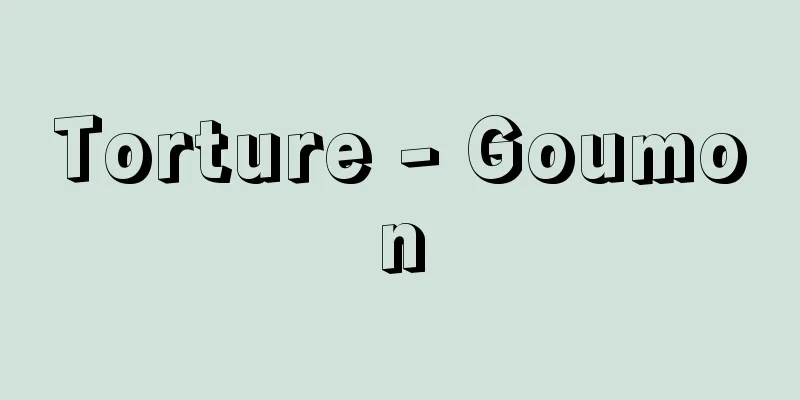Torture - Goumon

|
Inflicting physical pain on a defendant or suspect in order to obtain a confession. In inquisitorial proceedings, confessions were considered the "queen of evidence," and various torture methods were used to force confessions. In Japan, torture (romon) was permitted during the Edo period and continued into the early Meiji period, but was completely abolished in 1879 (Meiji 12). However, even after that, confessions were considered to be strong evidence in practice, and torture of defendants and suspects was not uncommon. The Constitution of Japan prohibits torture by public officials (Article 36), and explicitly guarantees this by providing the right to remain silent and denying the admissibility of confessions obtained through torture or intimidation (Article 38). Furthermore, the Code of Criminal Procedure stipulates that confessions that are doubtful of their voluntariness cannot be used as evidence (Article 319). [Ryosuke Ishii] HistoryIn ancient China, as a rule, criminals were expected to be punished only after they confessed, and torture was permitted to coerce confessions. In the Tang dynasty's Ritsuryo, which was the mother law of the Japanese Ritsuryo and had a well-established system, torture was called gojin or goryaku, and was permitted only when a suspected criminal did not confess, or when the facts of a crime could not be revealed without the prisoner's confession. The method of torture was beating with a cane, but there were restrictions such as the number of times not to exceed three times in a row and the number of strokes not to exceed 200 in a row. If an official illegally caused the death of a prisoner through torture, he was sentenced to two years in prison, and the Japanese Ritsuryo, which succeeded the Tang Ritsuryo, had similar provisions. In China, the system of torture has been permitted in successive dynasties since the Tang. According to Japanese ritsuryo, the jinjo (stick) used in torture was 3 shaku 5 sun long, 4 bu in diameter at the base, and 3 bu in diameter at the tip, and it was stipulated that the stick should strike half of the victim's buttocks and half of the victim's back. Torture was also practiced in the Middle Ages, and was permitted by the Kamakura Shogunate Law. There are records of torture such as fire torture, water torture, and wooden horse torture from the Middle Ages to the Warring States period, but the authenticity of many of these records is questionable. It was not until the Edo period, especially after the establishment of the Kujikata Osadamedaki in 1742 (Kanpo 2), that a system regarding torture was established. Although the torture referred to in the Edo Shogunate Law was tsurushizeme (suspension by hanging), what was called romon (prison detention, or tomo) at the time was also essentially torture. Rōmon was a form of torture in which prisoners were tortured in the penitentiary of the prison, and specifically, there were three types of torture: flogging, stone-holding, and shrimp torture. For flogging, the prisoner's hands were tied behind his back and his shoulders were hit. For stone-holding, if a prisoner did not confess after flogging, he was made to sit upright with his hands tied behind his back and stones (3 shaku long, 1 shaku wide, 3 sun thick) were placed on his bare knees. The number of stones was gradually increased from 2-3 stones to 7-8 stones, and sometimes even 10 stones. If a prisoner did not confess after repeated flogging or stone-holding, shrimp torture was performed. For shrimp torture, the prisoner was made to sit cross-legged and a rope was tightened around his neck and ankles, bending his body like a shrimp. Flogging and stone-holding were often performed, but shrimp torture was rarely performed. If a prisoner did not confess after being whipped, he was tortured (tsuri-jime). Tsuri-jime was carried out in the torture cellars of the prison, where the body was hung in the air (with the feet about 3 inches above the ground) with both hands tied behind the back. Torture was considered no easy thing to do at the time, and it was only used on cases of murder, arson, theft, breaking into a checkpoint, conspiracy, and cases where the crime had not been determined during the investigation but another crime had been discovered and the charges were clear and the death penalty was to be imposed on that crime alone, and the person did not confess despite the evidence of wrongdoing being solid. In reality, torture (tsuri-jime) was not used very often. This is thought to be because it was thought that if a person could not be made to confess without torture, it would show the incompetence of the investigating officials, and if the person did not confess even after torture, it would be a disgrace to the Shogunate. Even in the Meiji era, the New Code of Prison Law enacted in 1870 (Meiji 3) stipulated the use of a cane for torture, and the Prison Execution Rules enacted in 1873 added the abacus as an instrument of torture. The Revised Code enacted the following year stipulated that "in general, a conviction for a crime shall be based on oral testimony." At the time, there was strong opposition to the torture system, and in 1876 the government revised the provision of the Revised Code to read, "in general, a conviction for a crime shall be based on evidence." However, because torture itself was not banned, torture continued to be used, but in 1879 all provisions relating to torture were deleted, and torture was eliminated from the legal system. [Ryosuke Ishii] [Reference items] | | |Source: Shogakukan Encyclopedia Nipponica About Encyclopedia Nipponica Information | Legend |
|
自白を得るために被告人・被疑者に対して肉体的苦痛を与えること。糾問主義手続では、自白は「証拠の女王」とされ、自白を強要するためにさまざまな拷問が用いられた。日本でも、江戸時代には拷問(牢問(ろうもん))が認められ、明治初期に及んだが1879年(明治12)にまったく廃止された。しかしその後も、自白は実際上有力な証拠と考えられ、被告人や被疑者に対する拷問は少なくなかった。日本国憲法においては、公務員による拷問を禁じ(36条)、その保障規定として黙秘権、拷問や脅迫による自白の証拠能力の否定(38条)を明文化し、さらに刑事訴訟法で、任意性に疑いある自白はこれを証拠とすることができない(319条)と規定している。 [石井良助] 沿革中国では古来、原則として罪人はその自白をまって処罰すべきものとされたから、自白を強要するために、拷問が認められていた。その制度のよく整い、かつ日本律令(りつりょう)の母法となった唐の律令(りつれい)では、拷問のことを拷訊(ごうじん)または拷掠(ごうりゃく)といい、犯罪の疑いがあるのに自白しない場合、および囚人の自白によらなければ犯罪事実を明らかにできない場合にだけ、拷問を許している。拷問の方法は杖(つえ)で打つことであるが、その回数は前後を通じて三度を超えることをえず、杖数(じょうすう)は前後を通じて200を超えることをえないなどの制限があり、もし官司が拷問によって不法に囚人を死に至らしめた場合は徒(ず)2年の刑に処せられたが、唐律令を継受した日本律令にも同様の規定があった。中国では唐以後歴代、拷問の制を認めている。 日本律令では拷訊に用いる訊杖(じんじょう)は、長さ3尺5寸、元が直径4分、先が直径3分で、臀(しり)と背とを半分ずつ打つ定めであった。拷問は中世でも行われ、鎌倉幕府法でもこれを認めている。中世から戦国時代にかけて、火責め、水責め、木馬責めなどの拷問が行われたとの記録があるが、これらの記録のなかには、信憑(しんぴょう)性が問題になるものが少なくない。拷問に関する制度が整ったのは、江戸時代、ことに1742年(寛保2)公事方御定書(くじかたおさだめがき)の制定以後である。もっとも、江戸幕府法上拷問とよばれたのは釣責(つるしぜ)めであるが、当時牢問(ろうもん)(ろうどい、とも)とよばれたものも実質的には拷問であった。牢問は牢屋敷内の穿鑿(せんさく)所で痛めつけることであって、具体的には笞(むち)打ち、石抱(いしだ)き、海老(えび)責めの三つを牢問という。笞打ちは、囚人を後ろ手に縛って肩を打つのである。石抱きは、笞打ちで白状しないときに、後ろ手に縛ったまま、正座をさせ、裸の膝に石(縦3尺、横1尺、厚さ3寸)をのせることで、その数は2~3枚から、だんだん増やして、7~8枚から10枚になったこともある。笞打ちまたは石抱きを繰り返しても白状しない者には、海老責めを行う。海老責めは、あぐらをかかせ、縄で首と両足首を締め寄せて、身体を海老のように曲げるのである。笞打ちや石抱きはしばしば行われたが、海老責めはめったに行われなかった。牢問をしても白状しないときに、拷問(釣責め)を行う。釣責めは、両手を後ろ手に縛って、身体を宙に(足下が地上から3寸ぐらい)つり上げることで、牢屋敷内の拷問蔵で行われた。拷問は当時、容易ならざることとされ、その行われるのは、殺人、火付け、盗賊、関所破り、謀書謀判および詮議(せんぎ)中で罪が決しないが、他罪が発覚して、その罪状が分明であって、その罪だけで死刑が行われるべきものに限り、かつ悪事をした証拠が確かなのに、本人が白状しないことを要した。実際には、拷問(釣責め)はあまり行われていない。それは、拷問しなければ白状させられないのは、吟味役人が無能であることを示すものであるし、また拷問をしても白状しないときは、幕府の威光にかかわるとされたからであると考えられる。 明治時代になってからも、1870年(明治3)制定の新律綱領は訊杖による拷問を定め、73年制定の断獄則例は拷問具として算板(そろばん)を追加した。翌年制定の改定律例は「凡(およ)ソ罪ヲ断ズルハ口供結案ニ依(よ)ル」と定めた。当時、拷問制度に対する反対論が強く、政府は76年に、前記の改定律例の規定を「凡ソ罪ヲ断ズルハ証ニ依ル」と改めた。しかし、拷問そのものを禁止しなかったので、拷問は依然そのあとを絶たなかったが、79年に拷問に関する規定はすべて削除され、制度上、拷問は消滅した。 [石井良助] [参照項目] | | |出典 小学館 日本大百科全書(ニッポニカ)日本大百科全書(ニッポニカ)について 情報 | 凡例 |
>>: Lock - Komon (English spelling) lock
Recommend
Woven cushion - vaginal discharge
...It was used at great banquets during the Heian...
Aidoo, AA (English spelling) AidooAA
…However, the movement to redefine popular histor...
Gomel - Gomeri (English spelling) Гомель/Gomel'
The capital of Gomel Oblast in the Republic of Be...
Activity level - activity
This is the effective value of concentration used...
Mr. Hatano
A medieval military commander and local lord of Ta...
Minor scale (English notation)
A diatonic scale, the counterpart of the major sc...
Columbia (animal) (English spelling) Columbia
...They are highly adaptable to the climate and e...
Lapparent, ACde (English spelling) LapparentACde
…A. Penck, who succeeded Richthofen, wrote “Morph...
Capricorn - Capricorn
〘Noun〙① A line of latitude on Earth that is 23 deg...
Law Concerning the Regulation of Acceptance of Contributions, Deposits, and Interest Rates, etc.
Law No. 195 of 1954. It is commonly referred to as...
avunculocal
...In contrast, in the case of cousin marriages a...
Artuqid dynasty - Artuq
A Turkmen dynasty that existed in the Diyarbakir r...
Ogoto - Ogoto
A place name on the western shore of Lake Biwa, in...
Advection fog - Iryugiri (English spelling)
Fog formed when moist warm air moves over the cold...
Hebrew letters - Heburaimoji
The Israelites or Jews of Palestine in the first ...









